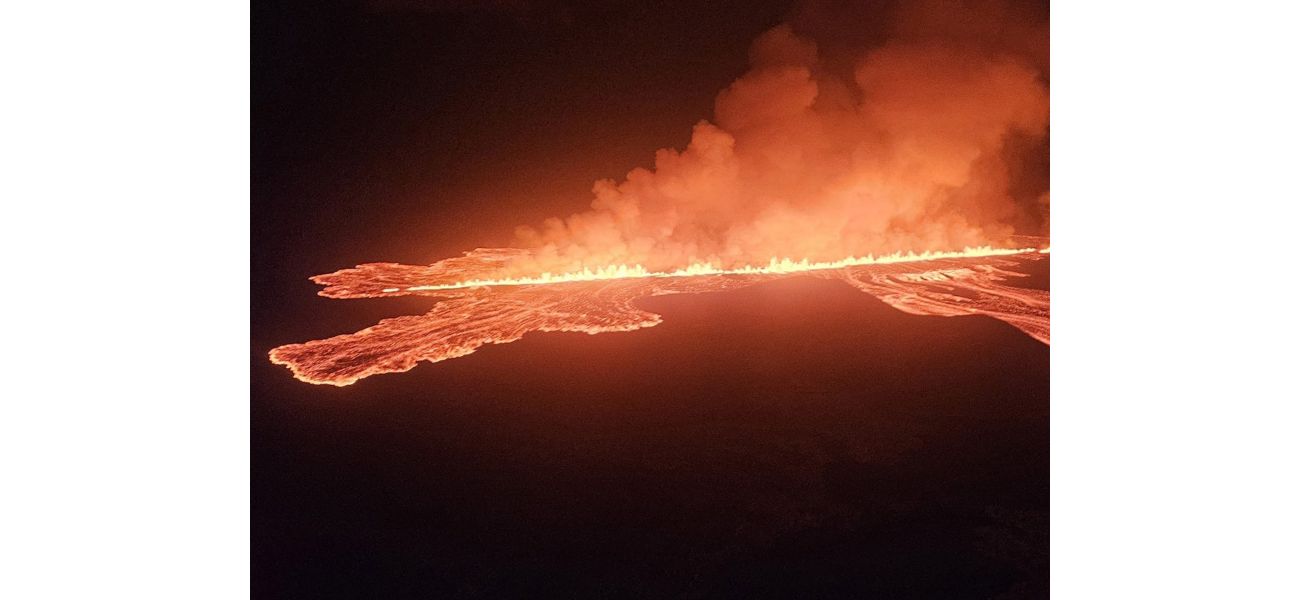Iceland's massive volcano on Rekjanes Peninsula erupts once more.
Volcano has erupted seven times in less than a year.
November 21st 2024.

The news of a volcanic eruption in Iceland has once again grabbed the attention of the world. This time, it is the Reykjanes Peninsula that has become the center of activity. This is the seventh eruption to occur on the peninsula this year, making it quite a rare event. The eruption started on Wednesday night with little warning, giving residents only 45 minutes to evacuate their homes and businesses. The town of Grindavik was most affected, with its 3,800 inhabitants forced to relocate.
The eruption, which began at 11:14 pm on Wednesday, is the seventh to occur since December 2023 and the tenth in the past three years. However, it poses no threat to air travel. Despite this, authorities have warned of harmful gas emissions in the surrounding areas. The Reykjanes Peninsula has been experiencing volcanic activity for some time now, with the last eruption occurring as recently as September 6th. This has caused damage to property and infrastructure, creating a difficult situation for the locals.
According to the Iceland Meteorological Office, the eruption is centered around a crack that remains very active. Lava is spewing west and north of the volcano, with the western flow moving at an alarming rate of 300 meters per hour. This has already crossed the Grindavík road and is approaching the Njarðvíkuræð pipeline, which provides hot water to the area. Although a fibre optic cable was severed due to the eruption, the pipeline is expected to hold, as confirmed by Hjördís Guðmundsdóttir, spokesperson for Civil Protection.
In a statement to state broadcaster RUV, Hjördís explained that this situation was already anticipated. The traffic through the severed fibre optic cable has been rerouted, and key infrastructures in the region are not at risk. However, the eruption has caused some disruptions, such as the relocation of residents and the interruption of services. But according to Magnús Tumi Guðmundsson, a professor of geophysics who flew over the eruption with the Civil Protection agency, the situation is not as dire as it may seem.
“In the big picture, this is a bit smaller than the last eruption and the one that occurred in May,” Magnús stated. He also added that Grindavik is not in immediate danger, and it is unlikely that the crack will get any longer. However, he cautioned that nothing can be ruled out at this point. Iceland, being situated above a volcanic hotspot, experiences eruptions every four to five years on average. Since the start of the current wave of activity in the Reykjanes Peninsula, ten eruptions have occurred, with the longest one lasting 183 days.
The recent eruption at Fagradalsfjall in March 2021 was the longest, producing a total of 150 million cubic meters of lava. However, its average daily output was much smaller compared to previous eruptions. On the other hand, a one-day eruption in February 2024 at Sundhnúksgígar produced 12.8 million cubic meters of lava, making it the most disruptive one in recent times. But nothing compares to the 2010 eruption of Eyjafjallajokull, which disrupted trans-Atlantic air travel for months due to the clouds of volcanic ash it spewed into the air.
Follow The Agency on Twitter and Facebook for the latest news updates. You can also receive our articles directly on your device by signing up for our daily push alerts. Thank you for reading and stay tuned for more updates.
The eruption, which began at 11:14 pm on Wednesday, is the seventh to occur since December 2023 and the tenth in the past three years. However, it poses no threat to air travel. Despite this, authorities have warned of harmful gas emissions in the surrounding areas. The Reykjanes Peninsula has been experiencing volcanic activity for some time now, with the last eruption occurring as recently as September 6th. This has caused damage to property and infrastructure, creating a difficult situation for the locals.
According to the Iceland Meteorological Office, the eruption is centered around a crack that remains very active. Lava is spewing west and north of the volcano, with the western flow moving at an alarming rate of 300 meters per hour. This has already crossed the Grindavík road and is approaching the Njarðvíkuræð pipeline, which provides hot water to the area. Although a fibre optic cable was severed due to the eruption, the pipeline is expected to hold, as confirmed by Hjördís Guðmundsdóttir, spokesperson for Civil Protection.
In a statement to state broadcaster RUV, Hjördís explained that this situation was already anticipated. The traffic through the severed fibre optic cable has been rerouted, and key infrastructures in the region are not at risk. However, the eruption has caused some disruptions, such as the relocation of residents and the interruption of services. But according to Magnús Tumi Guðmundsson, a professor of geophysics who flew over the eruption with the Civil Protection agency, the situation is not as dire as it may seem.
“In the big picture, this is a bit smaller than the last eruption and the one that occurred in May,” Magnús stated. He also added that Grindavik is not in immediate danger, and it is unlikely that the crack will get any longer. However, he cautioned that nothing can be ruled out at this point. Iceland, being situated above a volcanic hotspot, experiences eruptions every four to five years on average. Since the start of the current wave of activity in the Reykjanes Peninsula, ten eruptions have occurred, with the longest one lasting 183 days.
The recent eruption at Fagradalsfjall in March 2021 was the longest, producing a total of 150 million cubic meters of lava. However, its average daily output was much smaller compared to previous eruptions. On the other hand, a one-day eruption in February 2024 at Sundhnúksgígar produced 12.8 million cubic meters of lava, making it the most disruptive one in recent times. But nothing compares to the 2010 eruption of Eyjafjallajokull, which disrupted trans-Atlantic air travel for months due to the clouds of volcanic ash it spewed into the air.
Follow The Agency on Twitter and Facebook for the latest news updates. You can also receive our articles directly on your device by signing up for our daily push alerts. Thank you for reading and stay tuned for more updates.
[This article has been trending online recently and has been generated with AI. Your feed is customized.]
[Generative AI is experimental.]
0
0
Submit Comment





